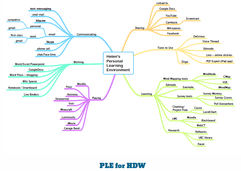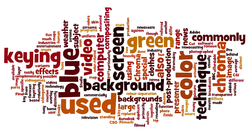7.2 Hands On - More PLAY you say!
Readings
|
Connecting and Understanding why Digital Storytelling is important - Humanity and Identity
The Importance of Writing your own story. |
Building a network of storytellers. |
Digital and Media Networks - PLNs
Let's talk about your media and digital PLN.
 The Networked Teacher
The Networked Teacher
As a media and digitally literate teacher, you need an awareness and an involvement in networks to encourage, engage and excite your personal and professional work.
Will Richardson, seen in the video clip to the right, calls all educators to become actively engaged in digital learning networks. His article titled Footprints in the Digital Age identifies networking as 'the new literacy' and encourages educators to be 'transparent and trackable'. According to Richardson, educators need to "own these technologies and be able to take advantage of these networked learning spaces in order" to "prepare students not just to be Googled well, but to be findable in good ways by people who share their passions for learning and who may well end up being lifelong teachers, mentors, or friends". The time has come to extend your digital network.
Will Richardson, seen in the video clip to the right, calls all educators to become actively engaged in digital learning networks. His article titled Footprints in the Digital Age identifies networking as 'the new literacy' and encourages educators to be 'transparent and trackable'. According to Richardson, educators need to "own these technologies and be able to take advantage of these networked learning spaces in order" to "prepare students not just to be Googled well, but to be findable in good ways by people who share their passions for learning and who may well end up being lifelong teachers, mentors, or friends". The time has come to extend your digital network.
Digital Stories - connecting the craft to the practice
 Image Links to Flickr source Image Links to Flickr source
Exploring the educational application of these tools and techniques within the digital storytelling genre can add new depth and interest for you and your students. Integrating short screen capture or green screen clips into a digital story can enhance and extend the story context, message and emotional connections. Individually, these techniques can be applied in the same storytelling process for short stories for genres that may be less exciting or interesting to students.
|
|
Here are some links to schools in Ontario that are actively creating a digital and media rich environment for literacy learning:
- Corliss Designs: Successful Learning, the Core of Corliss - look for the screencasts of the digestive system, the digital story of the Little Red Hen and many other examples of digital and media literacy in action
- Mrs. Black's Class Blog - local teacher who shares in a digital community & celebrates student learning using media
- Inquiry Based Learning - follow two teachers as they explore and integrate inquiry learning into the classroom
- Ontario Educators - Scoop.It collection of blogs created and written by Ontario educators
Dipping Into Augmentative and Virtual Reality
Using Aurasma or Google expeditions have potential in your classroom to engage and enhance digital storytelling.
|
|
|
Take a look
Authors are creating, writing, designing and building stories with Augmented [AR] and Virtual Reality [VR] in mind.
One example is Eric Carl who has created an AR interactive version of his story The Very Hungry Caterpillar.
Other examples can be found in this article How to Build a Better Digital Book.
One example found in this article is the IMAG.N.O.TRON app that supports the book The Fantastic Flying Books of Mr. Morris Lessmore. You can learn more about this app and how it works with the book in this YouTube video created by a school librarian.
One great resource to keep informed about the field of AR and VR, since it will shape and integrate into education, is the Digital Bodies web site.
See one integrated example from UBC Learning Commons - using Thinglink as a 'flat image' to showcase where AR is available within a physical space.
One example is Eric Carl who has created an AR interactive version of his story The Very Hungry Caterpillar.
Other examples can be found in this article How to Build a Better Digital Book.
One example found in this article is the IMAG.N.O.TRON app that supports the book The Fantastic Flying Books of Mr. Morris Lessmore. You can learn more about this app and how it works with the book in this YouTube video created by a school librarian.
One great resource to keep informed about the field of AR and VR, since it will shape and integrate into education, is the Digital Bodies web site.
See one integrated example from UBC Learning Commons - using Thinglink as a 'flat image' to showcase where AR is available within a physical space.
Resources/Links:
- Does Virtual Reality Need a Moral Code? Tech.Co
- How virtual reality technology is changing the way students learn, Jan 10, 2017. The Conversation
- Kasey Bell - Getting Started with Google Expeditions and Virtual Reality
- 16 of the coolest apps for Cardboard, Google's DIY virtual reality headset, Jan 2, 2016, Rob Price, Tech Insider
- Second Life for Teachers: Promises and Perils, video by Dallas McPheeters
- 32 Augmented Reality Apps for the Classroom from EdShelf, TeachThought

